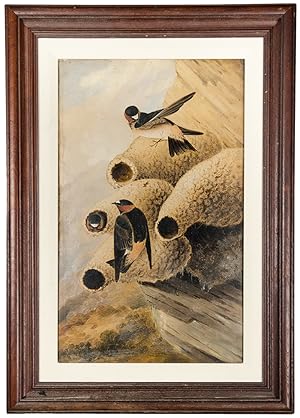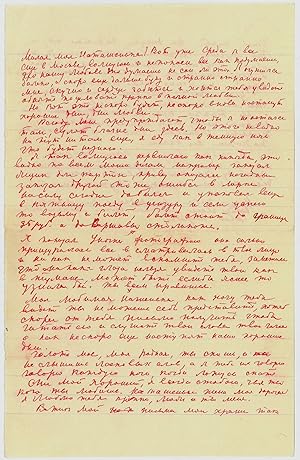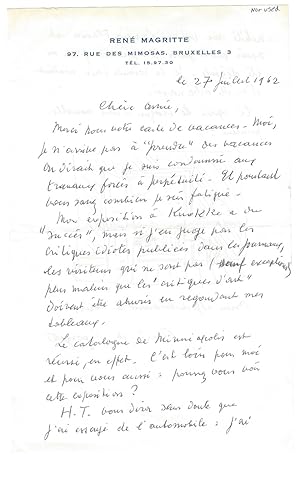Painting (Over 26,000 results)
Product Type Clear
- All Product Types
- Books (306,878)
- Magazines & Periodicals (1,960)
- Comics (168)
- Sheet Music (29)
- Art, Prints & Posters (18,443)
- Photographs (884)
- Maps (96)
-
Manuscripts &
Paper Collectibles (7,968)
Condition
Binding
Collectible Attributes
- First Edition (2,126)
- Signed (4,438)
- Dust Jacket (164)
- Seller-Supplied Images
- Not Printed On Demand
Free Shipping
Seller Location
Seller Rating
-
Le Problème du Fantôme. Sketchbook containing 49 sketches for an unpainted work.
Published by [Brussels, 1946]., 1946
Manuscript / Paper Collectible Signed
Sketchbook with 49 drawings, 6 are signed, one is dated "13 August 1946"; (5 1/2 x 4 1/8 in.; 140 x 105 mm); pencil or ink; the sketchbook is titled on the cover "Le Problème du Fantôme." Insight into Magritte's creative process. The sketchbook, used probably during the war, shows studies for several Magritte paintings made between 1941 and 1948: The Meteor (Sylvester, II, 559), The Civilizer (Sylvester, II, 574), The Tempest (Sylvester, II, 576) or Pure Reason (Sylvester, II, 659). - It presents also a remarkable series of studies of iconic Magritte references as hair, women, landscapes or leaves that resemble birds, used for different paintings such as Knowledge of the Natural (Sylvester, II, 488), Daily Bread (Sylvester, II, 497), The Rape (Sylvester, II, 580) or The Fire (Sylvester, II, 599).Others studies are traditional representations of ghosts (a large white sheet) in a Magrittian way (with a smiling face, with woman, a leaf, a ship, a balloon or a drop in the middle of the shadow) for a work he probably never painted. The "Ghost Problem" of the title remains unresolved. Provenance: Suzi Gablik.
-
Stunning original painting by Zdzislaw Beksinski (1929-2005)
Seller: Antiquariat im Kaiserviertel | Wimbauer Buchversand, Dortmund, NRW, Germany
Manuscript / Paper Collectible
Gemälde. Stunning original painting by Zdzislaw Beksinski (1929-2005). Signed on the backside as usual by Beksinski. From my own private collection. International shipping: please organise by yourself, I only ship inside Germany. Size: ca. 60 x 69 cm. First picture is the Painting in it's old frame, in which I got the picture from the former owner. I reframed it to protect it better (see other pictures). Wikipedia: Zdzislaw Beksinski (pronounced ['zd??iswaf b?k'?i?sk?i]; 24 February 1929 - 21 February 2005) was a Polish painter, photographer, and sculptor; specializing in the field of dystopian surrealism. Beksinski made his paintings and drawings in what he called either a Baroque or a Gothic manner. His creations were made mainly in two periods. The first period of work is generally considered to contain expressionistic color, with a strong style of "utopian realism" and surreal architecture, like a doomsday scenario. The second period contained more abstract style, with the main features of formalism.[1] Beksinski was stabbed to death at his Warsaw apartment on February 21, 2005, by a 19-year-old acquaintance from Wolomin, reportedly because he refused to lend him money.[2] I prefer a personal handover in North Rhine Westfalia, Germany. An insured delivery with a shipping company can of course be arranged. This auction is from my private property (no turnover tax included). No I sell it with my business account only for showing my real name and my eBay reputation, that I am not a random seller with no rating and feedback on eBay and elsewhere. Privatverkauf aus meiner Privatsammlung. Keine Mehrwertsteuer enthalten, wird nur über meinen Businessaccount angeboten, um die Seriosität des Angebots zu unterstreichen. /// Standort Wimregal kxx Sprache: Deutsch Gewicht in Gramm: 15000.
-
A Man of Prince William Sound
Published by Suungaacik, Alaska, 1778
Seller: Arader Books, New York, NY, U.S.A.
Manuscript / Paper Collectible First Edition
No binding. Condition: Near fine. First. THE ORIGINAL FIELD-SKETCH FROM CAPTAIN COOK'S THIRD VOYAGE. Suungaaciq, Alaska; 14(?) May 1778. Single sheet, mounted (8" x 4.5", 202mm x 115mm). Graphite, chalk and ink on paper. Near fine, with a little soiling. Mount marked "46" at lower left and "Natives of" [Prince Williams Sound] at lower right. Presented in a blue morocco clam-shell box. John Webber (1751-1793) was embedded as the expedition artist with Captain James Cook's third and final voyage. Cook set out in July of 1776, notionally to return Omai to his home in Ra'iatea in the Society Islands (French Polynesia), but in fact seeking the long-elusive Northwest Passage. Cook was the Admiralty's great hope, and was given an all-star crew aboard HMS Resolution with Charles Clerke in command of her companion HMS Discovery: William Bligh, George Vancouver, Nathaniel Portlock, William Bayly as astronomer and John Webber and artist. Cook's third voyage culminated in his death in 1779 during an attempted capture of the supreme monarch of Hawaii, KalaniʻŠpuÊ»u. Before that, however, he succeeded in the first mapping of the northwestern coast of America, filling in one of the great remaining cartographic gaps. He sailed north along what is now Canada and Alaska. Just south of Anchorage is the Kenai Peninsula; to the west is Cook Inlet and to the east is Prince William Sound (called "Suungaaciq" in Aluutiq), named for the third son of George III, who would later reign as William IV. Webber drew the present portrait (Joppien-Smith ad loc.: "a field-sketch") of a Chugach (traditionally "Pacific Eskimo") man while in southern Alaska in the summer of 1778. The man sports a moustache and goatee above stubble, a tied cloak and a conical hat with a flat top. An example of a Chugach spruce hat of a similar design is now held by the British Museum (Am,NWC.4); it was presented as part of a large group of material from the voyage by Sir Joseph Banks in 1780. Between this original sketch and the publication of the voyage in 1784 (as pl. 46; cf. the number at the lower-left of the mount), Webber's design underwent several revisions. A worked-up portrait with more detail in the garb is now at the Peabody at Harvard (41-72-10/502), and a final version at the Dixson Library at the State Library of New South Wales (SAFE/DL PXX 2/vol. 4, fol. 26). The present item, however, has all the freshness and vigor of a drawing made in the course of exploration -- one of the most famed and consequential voyages of all time. The drawing has a distinguished provenance. Francis Peloubet Farquhar (1887-1974, California historian and explorer) bought the painting from Francis Edwards's catalogue 551 (1930's?), no. 7. Farquhar's library was sold via Hordern House to William Reese (1955-2018), one of the great Americana dealers. Reese's private collection was sold by Christie's in May 2022; the present item was lot 289. Joppen, Rüdiger and Bernard Smith. The Art of Captain Cook's Voyages. New Haven and London: Yale University Press, 1988. Vol. 3 Cat. 3.238 (p. 475).
-
[Liber horarum - Use of Rouen].
Published by Rouen, Normandy, ca. 1480., 1480
Seller: Antiquariat INLIBRIS Gilhofer Nfg. GmbH, Vienna, A, Austria
Manuscript / Paper Collectible
Small 4to. Latin and French illuminated manuscript on vellum, 160 ff. Ruled in red ink for 14 lines per page (16 in the calendar). Gothic textura, major feasts in calendar in burnished gold, others alternately red or blue. Text pages illuminated with panel borders of flowers and plants on gold, and blue and gold stylised acanthus on a plain ground. Calendar has 24 small square miniatures set into panel borders; major text divisions marked by 12 large miniatures; 2 historiated initials; hundreds of smaller initials and line-fillers throughout. 18th century French red calf over pasteboards, gilt cover borders, spine gilt titled, marbled endpapers, all edges gilt. A Rouen Book of Hours of outstanding quality and in slightly larger than usual format, commissioned by a female patron who is portrayed in the last miniature awaiting the arrival of the Messiah. - The style of illumination is typical of that practised in Rouen during the late 15th century. Characteristic features include the profuse use of gold highlights on draperies and hillsides, often cross-hatched; cross-hatching of grassy areas in landscapes; a palette predominantly based on pink, blue, brown and green, and the use of grey for the modelling of facial features, men having rather swarthy flesh, and women very pale skin; the rather peremptory manner of painting hands; the grey-blue acanthus on flat gold backgrounds for borders. Also the liturgical use points to Rouen as the place of production: the sparse calendar includes St Romanus (23 October) in gold, as well as St Evodius (8 October) and Mellonus (22 October), all three were bishops of Rouen; Romanus and Mellonus also appear in the Litany. Prayers are written for the use of a female supplicant, and a conventional portrait of the original owner appears in the final miniature. - Contents: calendar, in French (f. 1r); Gospel extracts (f. 13r); prayers "Obsecro te" and "O intemerata", using feminine forms (ff. 20v); Hours of the Virgin (f. 31r), Lauds followed by suffrages to the Holy Spirit, Nicholas, and Katherine; Seven Penitential Psalms (f. 83r) followed by (f. 98r) a Litany of saints (Clement, Fabian, and Sebastian, at the bottom of f. 100r, are mistakenly repeated at the top of the verso); Hours of the Cross (f. 105) and of the Spirit (f. 109r); Office of the Dead (f. 113r); "Les quinze joies nostre dame" (f. 151r) and "Les sept requestes" of the Lord (f. 157r), both in French. - Illumination: the calendar (ff. 1r-12v) has occupations of the months on rectos, and zodiac signs on versos. January: feasting; Aquarius. February: warming at a hearth; Pisces. March: pollarding; Aries. April: half-length man in a garden; Taurus. May: man and woman on horseback, hawking; Gemini: a naked man and woman embracing. June: scything; Cancer. July: reaping; Leo. August: threshing; Virgo. September: treading grapes; Libra. October: sowing seed; Scorpio. November: knocking acorns from trees to feed pigs; Sagittarius. December: killing a pig; Capricorn. - The major texts are each introduced by a large miniature, including the individual Hours of the Virgin, except Vespers and Compline which have historiated initials: - 1. (f. 13r) The Four Evangelists, in a four-part miniature characteristic of Rouen. - 2. (f. 31r) The Annunciation, surrounded by a border composed of nine smaller compartments: three with angels, the other six with scenes from the life of the Virgin: Gabriel appearing to Joachim; Meeting at the Golden Gate; Nativity of the Virgin; Presentation of the Virgin; Virgin at the Loom; and Marriage of the Virgin to Joseph. - 3. (f. 44v) The Visitation. - 4. (f. 59r) The Nativity. - 5. (f. 65v) The Annunciation to the Shepherds. - 6. (f. 69v) The Adoration of the Magi. - 7. (f. 73r) The Presentation in the Temple; the infant has his arms outspread, visually prefiguring his Crucifixion. - 8. (f. 76v) The Flight into Egypt (historiated initial). - 9. (f. 78r) The Coronation of the Virgin (historiated initial). - 10. (f. 83r) King David in Penitence; the border with smaller miniatures depicting David and Goliath, and David Spying on Bathsheba. - 11. (f. 105r) The Crucifixion; the border with smaller miniatures depicting the Flagellation, and Christ carrying the Cross. - 12. (f. 109r) Pentecost. - 13. (f. 113r) A Funeral Service; the border with smaller miniatures depicting Death in the form of a cadaver killing a man, and a priest officiating at a burial. - 14. (f. 151r) The Virgin and Child enthroned, adored by an angel and a female patron. - Upper cover somewhat stained. A few minor blemishes (e.g. slight pigment loss in the lower right corner of the miniature on f. 31r, and slight water-staining in the lower left corner), but generally in fine, clean condition throughout, with ample margins. An erased 17th (?) century inscription in the lower margin of fol. 2r reads "Mon dieu que vous estez bon"; the same hand may have been responsible for lightly disguising the nudity that occurs in some marginal scenes, including Aquarius (f. 1v), Gemini (f. 5v) and Bathsheba (f. 83r). - 1) Purchased in 1949 from William H. Robinson, Pall Mall booksellers, per pencil note on verso of front flyleaf: "From Robinsons, 25/8/49", by 2) William Alfred Westropp Foyle (1885-1963), British bookseller, with his burgundy morocco gilt bookplate to front pastedown. 3) By descent to his grandson William Richard Mervyn Christopher Foyle (1943-2022), aviator and bookseller.
-
HABITANTE DE GOYAS, QUADRO A ÓLEO PINTADO SOBRE MADEIRA.
Art / Print / Poster
No binding. Condition: Good. Pintura a óleo sobre madeira com 24,5x30,5 cm. Representação de um habitante de Goyas montado a cavalo, procurando apartar um touro com uma vara e um laço. Panorama de fundo com palmeiras e cabanas. Imagem idêntica reproduzida na obra Voyage Pittoresque au Brèsil publicada em 1836. «Johann Moritz Rugendas nasceu em Augsburg em 1802 e faleceu em Weilheim am der Teck, Württernberg, em 1858. Era oriundo de uma família de pintores e, provavelmente, encontrava-se bem estabelecido quando foi recrutado pelo Barão Langsdorff para fazer parte da expedição ao Brasil. Uma vez no Rio de Janeiro, dissociou-se de Langsdorff e seguiu viagem por conta própria. É desconhecido o exato itinerário de Rugendas através do Brasil, mas sabe-se que visitou os principais estados do Norte e do Sul e esteve por certo tempo em Minas Gerais. Retornou à Europa em 1825 e viveu em Paris, em Roma e no sul da Itália. Em 1831 deu início a uma viagem ao México, Califórnia, Peru, Bolívia, Chile, e Rio da Prata, e no seu retorno permanecerá ainda por quase um ano no Rio de Janeiro. Em 1847 vivia em Württemberg, Weilheim, onde faleceu em 1858. Rugendas publicou muitos dos seus desenhos do México na obra de C. Sartorius. Dos vários lugares em que esteve deixou uma vasta coleção de desenhos e numerosas pinturas a óleo, retratos, etc., que se encontram dispersos em museus e coleções particulares. Em 1928, o pintor brasileiro W. Rodrigues adquiriu, do Museu da Bavária, um conjunto de cerca de cem desenhos do artista, que vendeu a colecionadores do Brasil e da Argentina. A obra Voyage pittoresque dans le Brésil foi publicada em 1835, quando Rugendas se encontrava ausente da Europa. Uma seleção de cem desenhos, na maioria desenhados ao vivo, foram litografados pela famosa imprensa de Engelmann. Parece que esse impressor não teve particular cuidado com os títulos exatos dos desenhos originais [?]». GOYAS DWELLER. Oil on wooden board. Oil on wood. Dim.: 24.5x30.5 cm. Depiction of a Goyas dweller, horseback riding, steering a bull with pike and "lasso". Background with huts and palm trees. Identical image reproduced in the work "Voyage Pittoresque au Brèsil" published in 1836. « Maurice Rugendas was born in Augsburg in 1802 and died in Weilheim am der Teck, in Würtenberg in 1858. He came from a family of painters and was probably well established when he was recruited by Baron Langsdorff to join an expedition travelling to Brazil. He parted company with Langsdorff in Rio de Janeiro and set out on his travels by himself. The itinerary of Rugendas travels in Brazil is unknown but we know from his drawings that he visited the main states, from north to south, and stayed in Minas Geraes. He returned to Europe in 1825 and lived in Paris, Rome and the South of Italy. In 1831 he began another voyage to Mexico, California, Peru, Bolivia, Chile and the Rio de la Plata. On his return journey he stayed in Rio de Janeiro for almost a year. He was living in Württemberg, at Weilheim, in 1847 and died there in 1858. Rugendas published many drawings of Mexico in the work of Sartorius. He left a vast collection of drawings and numerous oil paintings, portraits, etc., of the many places in which he stayed. They were scattered in museums and private collections. In 1928 the Brazilian painter, W. Rodrigues, bought a collection of around hundred drawings from the Bavarian Museum and sold them to collectors of Brazil and Argentina. The Voyage pittoresque dans le Brésil was published in 1835 while Rugendas was not in Europe. A selection of a hundred drawings from the numerous ones made on the spot were lithographed by the famous press of Engelmann. He apparently did not take particular care in writing the exact title of the original drawings. Alfredo de Carvalho noted that plate 30 from Section 1 (View of Olinda) and plate 29 from Section 3 (Mass at Candelaria Church at Pernambuco) do not depict the places indicated in the title. Probably other mistakes exist in the location of other places. Two editions of the work were published, one in French and another in German, both in 1835. The text is not by Rugendas himself, however, but was written by V. A. Huber and others from the artist's letters and notes. The French text is a translation made by Colbery. This is not without value despite the romantic outpouring in many pages which has nothing to do with the main subject, but it does not reach the standard of the genuine documentary value of the plates, which are of utmost importance for the study of the Brazilian life at the beginning of the nineteenth century [.] ». Borba de Moraes 1983, Tomo II, pág. 754: " 36x26 cm; 51 pp. (text in 2 columns, 40 lithographs) Language: Português / Portuguese Location/localizacao: PCS-05.
-
Psalter in Latin, illuminated manuscript in Latin on vellum
Published by Northern France/Flanders, (Picardy or Ghent?), last decades of 13th century
Seller: Sokol Books Ltd. ABA ILAB, London, United Kingdom
Manuscript / Paper Collectible
Hardcover. Condition: Good. 113 by 77mm, 228 leaves (plus one modern paper endleaf at front and back), wanting a gathering or so from beginning with Psalms 1-14 and perhaps also a Calendar, as well as first two leaves of current initial gathering (accordingly nineteenth-century pencil foliation commencing at 14 , and that used here), else complete, collation: i6 (wanting first 2 leaves), ii-xix10, xx-xxiii8, xxiv10, single column, 18 lines in a fine squat early gothic bookhand, a cacophony of line-fillers forming geometric shapes formed of red and blue penwork, small flower heads, golden fish and golden dragons with long trailing tails, small initials in blue with red penwork or liquid gold with blue penwork, the penwork often tracing long curling lines into upright margins and simplified foliage in lower margins, larger initials in liquid gold on dull-pink and blue grounds with angular gold edges, one large initial C (opening Confitebor tibi domine , the opening of Psalm 111, here fol. 200r) in blue with scalloping white penwork on pink and gold grounds, enclosing tightly curled swirls of foliage, and a noblewoman in white headdress on its top edge, kneeling as a bishop blesses her (most probably an ownership portrait, see below), nine historiated initials in blue or pink on gold and coloured grounds, many tags added to outer upright edges of leaves to aid finding parts of text, the last five historiated initials with a missing word or two following the initial where the scribe assumed the initial painter would add these but did not, in all but one place (fol.109v) these supplied by a contemporary hand in blue ink, two leaves with blank margins trimmed at base, some slight worming to last leaf, small spots and stains, else good condition, art deco red leather over pasteboards tooled with lined squares, traces of medieval fore-edge painting to resemble gauffering. Text and Illumination: The volume comprises Psalms 15-150, followed by the Magnificat, a Litany and other prayers. The initials here compare well with the refined works of this region in the last decades of the thirteenth century (such as the Psalter for the use of Ghent, mid-thirteenth century, now Getty MS. 14; 85.MK.239, and the Bestiary from Flanders, c. 1270, now Getty, MS. Ludwig XV 3;83.MR.173: see Kren, Illuminated Manuscripts from Belgium and the Netherlands, pp. 40 and 44-6; and the Bute Psalter, made north east France c. 1270, now Getty MS. 46;92.MK.92: see same series for French manuscripts, pp. 31-32), and sets it well above the more commonly found rustic examples. The historiated initials contain: 1. fol. 30v, David as a crowned king with a long staff, touching his eyes as God blesses him (opening Dominus illuminatio mea , Psalm 26); 2. fol. 50r, God appearing from a cloud and blessing an enthroned David (opening Dixi custodiam vias , Psalm 39); 3. fol. 67v, David brandishing a sword before a Jewish religious leader, probably representing Ahimelech to whom the text is addressed (opening Quid gloriaris in , Psalm 51); 4. fol. 68v, King David standing before a fool representative of those who work iniquity, who have devoured my people like a loaf of bread , who holds a staff and bites from a circular piece of bread (opening Dixit insipiens in , Psalm 52); 5. fol. 86v, Christ and David in different compartments of an initial, with Christ blessing while David is half-submurged in water (opening Salvum me fac , Psalm 68); 6. fol. 109v, David with a stick ringing the bells hanging from a stone church (opening E[xultate] deo nostro , Psalm 80); 7. Fol. 130r, three tonsured monks singing from a book on a lectern (opening Cantate domino canticum , Psalm 97); 8. fol. 133r, David in prayer on the Mount of Olives (opening Domine exaudi orationem , Psalm 101); 9. fol. 153v, the Crucifixion, with God the Father holding Christ on the Cross (opening Dixit dominus , Psalm 109). An elegant and high quality psalter rare.
-
Catching Fire
Published by Nathan Walsh Art, 2016
Seller: William Collins Rare and Collectable Books, Grimsby, United Kingdom
Art / Print / Poster First Edition Signed
No Binding. Condition: Fine. No Jacket. 1st Edition. Catching Fire - Nathan Walsh 135cm x 275cm - Oil on Linen. An incredible original by famous contemporary realist artist Nathan Walsh. "The paintings can be very labour intensive. The largest paintings, Catching Fire and Peninsula took almost a year to make each. I spend six days a week in the studio for often long hours . Signed by Author(s).
-
Wah-ro-née-sah, the Surrounder, Chief of the Tribe. (Chief of the Ottoes, #117)
Published by George Catlin, Fort Leavenworth, Kansas, 1832
Seller: Donald A. Heald Rare Books (ABAA), New York, NY, U.S.A.
Art / Print / Poster
Watercolor. Watercolor over graphite, heightened with white gouache on cream wove paper, inscribed "Chief of the Ottoes" in the bottom right-hand corner, and numbered "117" in the top right-hand corner. Image: (9 5/8 x 6 3/8 inches). Framed: (18 x 14 1/2 inches). An early, previously unrecorded watercolor study of a Native American chief for a George Catlin oil painting now held in the National Portrait Gallery at the Smithsonian. "[I] painted thus many of my pictures in water colors during my 8 years travels, and most, though not all of them, I enlarged onto canvas, wishing my collection to be all in oil painting." - George Catlin During the 1830s, Catlin, a self-taught artist from Philadelphia, traveled through the Great Plains of the American West, absorbing the ways of the Native American tribes he found flourishing there. Over the next decade, Catlin embarked on a journey to create a faithful visual study of the members, customs, and surroundings of the tribes who welcomed him, which culminated in his print publications of North American Indian life. Troccoli suggests that Catlin traveled with a sketchbook in which he made preliminary watercolor studies of his subjects, which he later mounted and finished. The finished paintings that Catlin produced following these trips were exhibited in his Indian Gallery, where he hoped to share the nobility of Native Americans and their cultures, as well as convey the devastating impact the Indian Removal Act of 1830 had on many of the tribes. Catlin described Wah-ro-née-sah as "quite an old man; his shirt made of the skin of a grizzly bear, with the claws on." The Surrounder was Chief of the Ottoe tribe, and lived in a spacious timber lodge perched on a ridge overlooking the Platte River. His bear claw necklace suggests he was a member of the Bear Clan, which shared leadership of the Ottoes with the Buffalo Clan. Another Catlin watercolor of Wah-ro-née-sah is held in the Gilcrease Museum's collection, but it dates from the early 1840s and is much smaller than the present "cabinet picture." The Gilcrease variant was likely painted after the present work, and intended to be used as a model for an illustration. Other examples of Catlin's watercolors held in the Gilcrease collection are more suitable comparisons, particularly the earlier portraits associated with Catlin's visit to the tribes living around Cantonment Leavenworth in 1830. These portraits all share the same careful modeling of the heads with wash laid over graphite underdrawing, alongside a much looser execution of the torsos. Catlin produced a fully realized oil painting after the present watercolor study of Wah-ro-née-sah, which is now held in the Smithsonian American Art Museum. The larger oil painting is a faithful translation of the watercolor, if lacking its immediacy. An aquatint engraving by J. Harris after the present Catlin study, held by the New York Public Library and Harvard among other institutions, was executed for James Cowles Prichard's Natural History of Man, (London and New York:1855) and is Plate LIII in that book. The provenance of this watercolor is of especial historical import. Captain William Henry Shippard, who Catlin describes in his Notes of Eight Years' Travels and Residence in Europe, as "my best of friends," acquired the present watercolor study, among others of Catlin's works, directly from the artist in the 1840s. Their relationship is well documented by written correspondence. Shippard, an English army officer and expert on Mexican antiquities, had a short-lived Museum of History in London, which Catlin praised in his book. Shippard worked on behalf of Catlin in attempts to sell his collection of Native American paintings and to exhibit his work in the UK. Shippard also assisted Catlin in his research at the British Museum. The present watercolor passed by descent through Shippard's family until it was auctioned in 2019 when it was sold for $145,214. Catlin, A Descriptive Catalogue of Catlin's Indian Gallery, no.117, p.16. Catlin, Catlin's Notes of Eight Years' Travels and Residence in Europe, p.63. Gurney and Heyman, George Catlin and His Indian Gallery, p.126. Prichard, Natural History of Man, Plate LIII, p.547. Troccoli, First Artist of the West: George Catlin Paintings and Watercolors from the Collection of the Gilcrease Museum, p.20. Truettner, The Natural Man Observed, p.131.
-
No Binding. Condition: Very Good. About the painting. Oil on board. Without the frame, painting measures approximately 21 x 24 inches. Signed "Danby" upper left corner with the year 56, below signature. We cannot definitively state if this painting was painted by Ken Danby. We have contacted numerous art dealers as well as Danby's estate and the consensus is that it could have been painted by him, however, it may very well not have been painted by him. We are still in the process of authenticating this piece. An early exhibition catalogue from one of Danby's exhibitions mentions that a teacher from Danby's high school bought two of his paintings while still a student. Is this one of them? We are actively looking for pictures of Danby's family. Is this painting of Danby's paternal grandfather? Questions remain. Painting was framed in Etobicoke, now Toronto. Additional photos/questions available upon request. Signed by Author(s).
-
Collection of 39 autograph letters signed, in French, to the Art critic Vittorio Pica, comprising 13 letters and 26 cards.
Published by , 1898 1926., 1926
Manuscript / Paper Collectible
74 pages (48 pages Small 4to and 8vo and 26 pages 12mo). 15 autograph envelopes. An important and unpublished archive of letters from James Ensor to Vittorio Pica. Vittorio Pica was an influential Italian art critic and one of the earliest defenders of Modernism in painting. This correspondence, spanning more than 20 years, covers a large part of James Ensor key artistic development including his intense study of the effects of light (inspired by the Flemish Old Masters). His lack of affiliation with any existing artistic movements, as well as the public s and contemporary artists lack of interest in his art, are made clear in the first part of the correspondence (1898-1899). He asks Pica repeatedly to write an article about him in the Emporium, an important and influential art review. He describes articles written by Maeterlinck, Verhaeren, Demolder for La Plume (the letter to Léon Deschamps is about this article and an exhibition in Paris) and La Libre critique, and sends Pica etchings to show him recent work. In several letters Ensor asks Pica to act as his agent and contact museums in Italy, especially in Venice and Naples. After two years of correspondence, Pica has still not written his promised article on Ensor. In April 1899, Ensor speculates that there may be a plot against him: "Mes ex-imitateurs devenus logiquement mes ennemis acharnes ont certes, par leur malveillance et critiques concertes retardes longtemps mon succès ( ) Votre silence me parait anormal." He complains that the etchings Pica has are too old to be representative of his art. In December 1899, he writes that he has learned about the publication of Pica s next book, À Travers les Albums et les Cartons, in which he hopes Pica will discuss his art. He proposes to send Pica photographs or etchings of important paintings such as Le Lampiste, Entrée du Christ à Bruxelles, and Mardi Gras 1889. He gives Pica information about the Belgian artistic scene, exhibitions, artists he respects. In his letter of 12 March 1900, he writes as post-script a very interesting and important "study" of Belgian/Flemish art and artists and art critics as compared to classical French 19th-century painters: "PS: L exposition la Libre Esthétique est ouverte à Bruxelles. La critique belge défend passionnément tous les artistes considérés à tort ou à raison comme artiste flamands et par contre juge très sévèrement les artistes novateurs. C est là une erreur manifeste car depuis Brueghel et Rubens, l art flamand est bien mort. L art flamand ou plutôt belge est composé depuis 1830 de reflets et d ombres. Nos bons peintres belges descendent de l étranger, il faut bien le reconnaitre. Descendant de Courbet: Louis Dubois, H. Boulenger, Alfred Verhaeren, enfin tous les paysagistes belges sans excepter les très récents Courtens, Gilsould, etc, etc. Descendant de David, peintre révolutionnaire: Navez, de Keyser, Wappers, de Bieve, Wiertz même, admirateur de Rubens mais peintre académique et très piètre coloriste ( ) Descendant de Manet: tous les Impressionnistes belge. Emules de Signac: Theo van Rysselberghe. Héritier de Bastien Lepage, Burns Jones, Holbein, Kate Greenaway: Fernand Khnopff. Sorte de Watteau courbétisé: Alfred Steven ( ) Seul Eugène Delacroix le plus Rubénien des peintres français n a pas eu un reflet en Belgique. Indice significatif. Le flamand n est plus coloriste. L art flamand est mort, bien mort, alors pourquoi ressusciter ce grand cadavre ( )".In May 1900, Pica s study of Ensor is finally published in the journal Minerva. After publication of the critical piece in Minerva, the tone of the letters changes. From "Dear Mr. Pica," Ensor switches to "My dear Pica." The letters becomes more personal; and as he becomes more confident, Ensor reveals more of his philosophy of art. The letter of 17 November 1902 is, for this reason, quite interesting: Ensor discusses a drawing which he has sent to Pica, Guirlande fantastique, which he fears is "too odd." He depicts in this drawing "une humanité grotesque et débridée confinant à la mascarade, évoluant dans un mauvais jour et enguirlandant de monstruosité la mélancolique figure d artiste personnifiant l oiseau de la sagesse ou d exception," appropriating for himself the figure of the under-rated artist as a bird used by Baudelaire in the famous poem L Albatros. "Je représente volontiers la triste humanité s abandonnant à ses mauvais ou grotesque instincts et ma devise est Peste dessous, Peste dessus, Peste partout (Plague below, Plague above, Plague everywhere). Certes, c est là la règle et j ai toujours trouvé partout fourberie, mensonge et dissimulation et j ai toujours vu ramper devant le fort et écraser le faible. Triste humanité baignée de limon, cette situation ne peut échapper à l artiste sensible et clairvoyant et voit influencer ses sujets. ( ) Je suis fier d être considéré en artiste d exception et souhaite pouvoir planer au-dessus des coutumières turpitudes et les cingler sans merci du crayon et de la pointe. J en appelle aux vieux humouristes mais cette race de grands hommes libres serait-elle éteinte et nos artistes modernes semblent rester indifférents devant les pires turpitudes. ( ) Il m est permis de peindre et graver pendant les jours insuffisants et sans soleil de l hiver, triste saison inspiratrice de mélancolie où dans les climats du nord la maladie et les ténèbres règnent en souverains et où la mort fauche impitoyablement parmi les gaités forcées des carnavals factices." He then pays respect to his friend Pica,one of the rare critics who understood his art when he was criticized by everyone in the Belgian art world.He begins taking advice from Pica and agrees to retouch a drawing he offered to Pica. He wants to hear Pica s feelings about his paintings and remarks on how they were described by Belgian critics: "Etes-vous satisfait du coloris et clarté et de l enveloppe d air et de la personnalité de la vision?". He is bitter about the reception of his art and explain.
-
Pennsylvania Station New York WITH Pennsylvania Station, New York City Seventh Avenue and Thirty-Second Street
Published by New York, 1946
Seller: Arader Books, New York, NY, U.S.A.
Manuscript / Paper Collectible First Edition
No binding. Condition: Very good. First. THE BIRTH AND DEATH OF THE GREATEST BEAUX-ARTS BUILDING IN AMERICA. Magnanti, Angelo. Pennsylvania Station New York. New York: for McKim, Mead & White; ca. 1946. Graphite, ink and gouache on artist's board (visible: 63" x 32" visible, frame: 73 1/2" x 42 1/2"). A little foxing; not viewed out of frame. WITH Hughson, Hawley (after). Pennsylvania Station, New York City Seventh Avenue and Thirty-Second Street. Philadelphia: Ketterlinus for the Pennsylvania Railroad Co., 1910. Offset chromolithograph on card (sheet: 33 1/4" x 57 1/2", frame: 39 1/2" x 61 3/4"). Water damage to the lower edge, partially matted out. Not viewed out of frame. In 1910, the New York terminus of the Pennsylvania Railroad Company opened on two full blocks between Seventh and Eighth Avenues and West Thirty-First and Thirty-Third Streets. Charles Follen McKim was the lead architect at McKim Mead and White, the firm responsible for some of America's great buildings: the East and West Wings of the White House, Symphony Hall in Boston, the major clubs of New York (Century, Metropolitan, University, Harvard, Harmonie, Racquet & Tennis). The original Penn Station was considered the greatest of them all, a towering monument to American wealth, mobility and progress. Hawley Hughson (1850-1936) was born in London but became one of the preeminent chroniclers of American buildings. Although romanticized, his building portraits and panoramas are among the best documents of a period of rapid change that shaped the cities of the United States. His depiction of the brand-new Penn Station is among his most recognizable, and documents much of midtown Manhattan (the Plaza Hotel at 59th and Fifth is depicted in part at the left-hand side, the Hotel Martha Washington (now the Redbury on 29th St.) is at the right), as well as Queens and Brooklyn beyond. The skyscrapers were still to come; the tallest building in New York in 1910 was the Metropolitan Life Insurance Building. The station's flow of passengers increased and hit its zenith in 1945-1946, precisely when MMW commissioned the "decorator" Angelo Magnanti (1879-1969) to depict their renovation of the station to accommodate the surge of pedestrian traffic. This would eventually be installed as a mural in the station master's office (other surviving Magnanti murals are at the Dollar Savings Bank, the Frick Art Reference Library and the conference room of the U.S. Supreme Court; he also designed mosaic ceiling at the Williamsburg Savings Bank). The New-York Historical Society in its MMW archives holds a less-developed sketch (2":1' scale) executed in color with gilt, presumably as a proposal to the firm, signed and dated "A. Magnanti/ 1946." The present work is drafted quite precisely, with washes of gouache and ink in a quasi-grisaille depiction of a sectional view of the station. At the lower left is a view of lower Manhattan from the South, rendered in near-photographic accuracy. The combination of the age of air travel and the 1956 Federal Aid Highway Act signed by Eisenhower ended the dominance of railroads. The mural stood in the station-master's office until the destruction of the station in 1963, widely considered one of the great architectural travesties, and the proximate cause of modern historical preservation. The new Penn Station is generally reviled; only in 2021 was the sin somewhat redeemed with the opening of the Moynihan Train Hall in the James A. Farley Building across Eighth Ave. -- luckily also designed by McKim, Mead & White. The Magnanti drawing was acquired from the Swann "New York Sale" (lot 306) that took place just two weeks after September 11th, 2001. The Hughson chromolithograph was acquired at Bonham's New York 10 December 2014 (lot 197).
-
The Granite Gorge, Grand Canyon. Attributed to the United States Geological Survey topographer, Sumner Homer Bodfish, who accurately surveyed this section of Grand Canyon over three seasons, between 1878 and 1880, under the instruction of John Wesley Powell and Clarence Dutton.
Published by Sumner Homer Bodfish, 1882
Seller: Berrishill Books, Whitley Bay, United Kingdom
Art / Print / Poster First Edition Signed
No Binding. Condition: Very Good. No Jacket. 1st Edition. Granite Gorge is where the Grand Canyon is at its deepest, over 6000 feet deep, more than a mile in depth. The oil on canvas painting, with the initials S.B. and dated 1882, is 24.5 inches by 20.5 inches, framed 29 inches by 25 inches. The journey through the Grand Canyon on the Colorado River was the last great land exploration in continental U.S.A, which was undertaken by John Wesley Powell and his fellow pioneers in 1869. A hazardous journey that they only just survived. John Wesley Powell was voted the man of the decade in the United States because of the success of this daring achievement. The painting is attributed to the United States Geological Survey's Topographer, Sumner Homer Bodfish, who had been brought into the survey team by John Wesley Powell in 1878, the year before the formation of the United States Geological Survey as a government department, in 1879. It was John Wesley Powell and Clarence Dutton who gave Sumner Bodfish the difficult task of accurately surveying the deepest section of the Grand Canyon between the years 1878 to 1880, a huge undertaking, the results of which received considerable praise. In 1880 there was a significant shift in the way the landscape was documented. Thomas Moran s artistic over dramatized illustrations were giving way to the need for reality to be portrayed. In 1880, Clarence Dutton had initially hired both Thomas Moran and William Henry Holmes to participate in the latest U.S. Geological Survey. The style of the latter, a trained geologist, dominates, the aesthetics and goals have changed. In fact William Henry Holmes, Thomas Moran and Sumner Bodfish were all working for the USGS survey of the Grand Canyon in 1880. Could this shift in 1880 towards realism in the portrayal of the Grand Canyon have been the influence and motivation behind the Bodfish painting, or had his decision already been made? After a period of research, through both official and historical documents, a twelve page, fully referenced article, which attributes the painting to Sumner Homer Bodfish, was presented to, and published by, The Grand Canyon Historical Society. A PDF of this article can be sent to those interested in the painting. A unique piece of American pioneering history in one of the most spectacular landscapes in the world. More images and information can be supplied on request. Signed by Author(s).
-
Correspondence by and to Gusti Adler, as well as correspondence by third parties, including manuscripts, typescripts, visiting cards, greeting cards, envelopes etc.
Published by Various places, 1900-1984., 1984
Seller: Antiquariat INLIBRIS Gilhofer Nfg. GmbH, Vienna, A, Austria
Manuscript / Paper Collectible
Catalogued as 450 items, totalling ca. 1400 pp. The present correspondence archive includes, among many other items, 6 letters or cards by Peter Altenberg, 1 by Richard Beer-Hofmann, 10 by Lili Darvas, 2 by Kasimir Edschmid, 13 by Anton Faistauer, 1 by Egon Friedell, 1 by Heinrich Friedjung, 1 by Hermann Hesse, 54 by Max Kalbeck, 1 by Alma Mahler-Werfel, 3 by Ernst Matray, 1 by Max Mell, 5 by Princess Clementine Metternich-Sándor, 1 by Bella Paalen, 2 by Alfred Polgar, 1 by Erich Reiß, 74 by Ernst Schütte, 1 by Rudolph Slatin-Pascha, and 1 by Max Slevogt. - A very extensive segment of 92 letters is formed by the correspondence with Josef Maria Auchenthaller, amplified by 29 from his wife Emma and 15 from their daughter Maria Josepha, who took her own life in 1914, aged only 20. In a highly interesting autobiographical typescript written a year or two before her death, Gusti Adler recounts how her own family met that of the famous artist and how she, then only 14 years old, had fallen in love with Auchenthaller, 25 years her senior. - Gusti Adler, born in Brixen in 1890, was the daughter of the painter Maria Adler and the country squire and later journalist Heinrich Adler, brother of Victor Adler, the founder of the Social Democratic Worker's Party of Austria; her sister was the artist Marianne Adler. Trained as a sculptor under Richard Kaufungen in Vienna, she later focused on painting as well as on arts and crafts, in 1913 beginning to write criticism for the "Wiener Fremdenblatt". After relocating to Berlin she wrote for Viennese and local newspapers, using the pseudonym "Christoph Brandt", and edited works by Jean Paul and Georg Forster. - Through the intermediation of her childhood friend Helene Thimig she met Max Reinhardt in 1919 and soon embarked on a two-decade-long career as his private secretary and aide, organising not only the numerous details of the great director's private life but also most of his theatre productions, especially at the Salzburg Festival. In 1939 she followed Reinhardt to the USA and was an active member of his "Workshop for Stage, Screen and Radio". After Reinhardt's death in October 1943 she joined the documentation department of Warner Bros. in Hollywood, where she remained until her 80th year. - In 1946 she published her biography of Max Reinhardt, followed in 1980 by the sequel " aber vergessen Sie nicht die chinesischen Nachtigallen". Gusti Adler passed away in Hollywood in 1985. - A detailed catalogue is available.
-
His personal hardcover school notebook when Toulouse-Lautrec was about 12 years old, featuring the letters T L" affixed to the front cover.
Published by n.p., [1876], 1876
Manuscript / Paper Collectible
4to. 87 pages written in Latin in Lautrec's hand, as well as his ownership signature on the first page, H. de T. Lautrec". Although he adds "Fables d'Esope" beneath his name, the passages cover a vast array of topics typical of a 19th-century child's education, including summaries of events in classical history, moral reflections, religious lessons, and philosophical musings. Each piece is about a page long and headed with a brief title. Brief translated excerpts follow:The notebook begins with a passage entitled "Men s Firmest Defense Is in Piety," in part: "O Lord, blessed are they who have put their hope in You! For when desolation invades their spirits, oppressed with the burden of affairs, they flee to You, and then, forgetting their sorrows, they draw strength and peace of mind from their source. You shelter them in a paternal embrace and spread before them the sacred light of faith O most sweet, nourishing religion and most holy faith, who can live without you." Lautrec was raised by his devoutly religious and overbearing mother, and began his formal schooling in 1872 at the prestigious Lycee Fontanes in Paris, but withdrew in 1875 due to his poor health. His mother's presence in his life at this time is certainly discernible in his writings on religion and philosophy in this notebook.The piece on page 30 is headed "On Socrates," which is followed by "On Fables." The latter, in part: "What is a fable but a tale for the improvement of men s morals, generally wrapped in an amusing image, in which the pleasant and the useful, although most unlike in nature, conspire to mutually adorn and defend one another? What do you suppose that those ancient inventors of tales intended with so many and such ingenious fictions? Just to tickle the ears of their readers with a vain arrangement of words? Not at all, but rather, when they put trees and animals on stage, their aim was that the bad, contemplating their deformity as in a mirror, would avoid rashness in counsel, avarice in the search for wealth, pride in command, and fraud in all aspects of life." This is an especially interesting piece, as Lautrec studied the fables of Phaedrus and La Fontaine while in school and these likely informed the allegorical animals that appear in his late drawings.He further explores the classical world in "On the Phoenicians" on page 43, in part: "The Tyrians took their origin from the Phoenicians. Those who inhabited the seashore, being troubled by frequent movements of the earth in their homeland, founded a city that they called Sidona on account of the abundance of fish on those coasts, for the Phoenicians call fish sidon. Then many years later, having been driven out by the king of the Ascalonians, they took to their ships, leaving behind their homeland, and founded the city of Tyre a year before the fall of Troy." Although Lautrec s artwork presents an extreme departure from the classical style, his familiarity with the stories can be seen in his body of work, including his portrayals of Mademoiselle Cocyle as Helen of Troy in La Belle Helene.The last page takes a moralistic slant on classical figures in a passage entitled "On Flatterers," in part: "Flatterers think that they can seek the favor of kings to the extent that they imitate them, but it often happens that they reproduce their vices rather than their virtues, as one or another example will sufficiently demonstrate to be true. It is said that Alexander s head was bent down toward his shoulder, and his friends were in the habit of also going around with their heads bent down toward their shoulders. When Plato first came to Syracuse, Dionysius the Tyrant immediately devoted himself entirely to geometry, from which it is easily understood that everyone consequently became a geometer, following the king s example." Lautrec takes a strong stance against flattery in this passage, a principle he certainly held throughout his life his paintings were decidedly unflattering and direct.Interior pages in fine condition, with general wear, staining, and soiling to the covers. This is an incredibly fascinating notebook rife with content from the young Toulouse-Lautrec. It dates to what was arguably the most crucial period of his development, during the time that he broke his legs, permanently succumbing to dwarfism. While recuperating, he incessantly practiced drawing and painting. A truly magnificent and significant notebook.
-
Lowell Blair Nesbitt, Electric Tulip II, Oil Painting
Seller: RoGallery, Long Island City, NY, U.S.A.
Art / Print / Poster Signed
Condition: Fine. Artist: Lowell Blair Nesbitt, American (1933 - 1993)Title: Electric Tulip IIYear: 1980Medium: Oil on Canvas, signed and dated versoSize: 84 x 60 in. (213.36 x 152.4 cm).
-
Folium from the Album d'Authal of Charles de Croÿ, with painted views of, inter alia, "Het dorp Van Meselbrouck" (recto) and "Het dorp Van Rillart" (verso)
Publication Date: 1596
Seller: Arader Books, New York, NY, U.S.A.
Manuscript / Paper Collectible First Edition
No binding. Condition: Very good. First. LATE-RENAISSANCE PAINTED VIEWS OF BELGIUM ON VELLUM, FROM A DOCUMENTARY PROJECT WITHOUT RIVAL. Ca. 1596-1598. Gouache, gilt and silver gilt on vellum (sheet: 20 3/4" x 14 7/8", 526mm x 383mm; frame: 26" x 21"). With some flaking and craquelure of the pigment. Vellum a little cockled, as usual. Framed floating in UVIII plexiglass recto and verso. Charles III de Croÿ (1560-1612), 4th Duke of Aarschot, 5th Prince of Chimay and 5th Count of Beaumont, was the scion of one of the great German noble families. Charles III's great grand-uncle was William II de Croÿ, tutor to the future Holy Roman Emperor Charles V, and eventually his greatest councillor. Through him the family gained extraordinary wealth from the revenues of New Spain, as well as extensive properties throughout the Spanish Netherlands and environs: Hainault, Flanders and Brabant, Namur, Artois and Picardie. Consolidated over generations, the Croÿ lands increased not just agnatically but enatically. By 1590, his survey of his vast scattered real estate holdings came to be illustrated by the surveys -- a cadaster -- of Pierre de Bersacques. This vast array of views, plans and maps he gave to Adrien de Montigny (d. 1615) to turn into a series of sumptuous albums on vellum -- the most luxurious substrate for book-production and natural-history painting -- with heraldic, floral, figural and otherwise decorative borders. These "Albums de Croÿ" are a singular document of late-Renaissance Europe, as much a record as an ostentation. From 1596-1611 some 2,500 views came to fill 23 volumes; the project expanded from Croÿ properties to broader areas of the family's influence. The Album d'Authal passed from Charles III de Croÿ to his wife Dorothea, and thence by descent to his nephew Alexandre d'Arenberg (Charles himself was childless), and from him ultimately to Ludmilla d'Arenberg (1870-1953) and then to her son Engelbert Ernst de Croÿ (1891-1974), who lived at Authal in Austria; purchased at Sotheby's London 19 June 2001, lot 47 (£1,213,500). The present leaf, unnumbered, illustrates four villages (dorpen), combinining steep views for buildings and trees, and bird's-eye plans for the locations of rivers, roads and parcels. Of these seven plans, six (excluding the bottom-right of the recto) are labeled with cardinal directions (three with North at top, two with South, one with East). There are numbers in most plans, which doubtless corresponded to a key; there was, however, no text included with the album when purchased. The largest plan on the sheet depicts Messelbroek (in modern Flemish Brabant in Belgium) on the recto in the upper section, with the church of St.-Michel, still standing. Another plan of "Het dorp Van Messelbrouck" -- all captions are gilt -- is at bottom-right of the verso. At the bottom-right of the recto, unlabeled, is the town of Gossoncourt (Goetsenhoven in Dutch), now a neighborhood of Tienen in Flemish Brabant. The remaining two villages are within the municipality of Aarschot (like the others on the sheet in Flemish Brabant) which was de Croÿ's ducal domain. On the recto: Gelrode (captioned "ghelroy") with the (now-demolished) church of Weerde in Langdorp (about 3 1/2 miles northeast) included due to a copying error, in the lower-left. On the verso are three plans of Rillaar (Rillaer in French; "Het dorp Van Rillart" in the captions): at top-left, the church of Rillaar with its commons; at bottom-left and top-right two additional views of the village. The borders of each page are of no lesser importance than the plans. On the recto is a black border set with flowers: yellow and purple iris along the sides, daffodils, wild strawberries, tulips and perhaps a white dahlia at top-center. Verso is a fantastical Mannerist composition on a black background, with botanical elements (tulips, irises, lilies, a fruit), figural elements (long-necked leopards at the lower corners) and polychrome strapwork with the Croÿ arms at upper center, surrounded in scrollwork.
-
Armenian Gospel Book.
Published by Armenia, Iran or Anatolia, ca. 1700 / 17th or 18th century., 1700
Seller: Antiquariat INLIBRIS Gilhofer Nfg. GmbH, Vienna, A, Austria
Manuscript / Paper Collectible
8vo (120 x 162 mm). Armenian manuscript on polished laid paper. 261 leaves, 25 lines of Armenian calligraphy in black ink, 2 columns, capitals in red. With a full-page colour frontispiece illustration of an evangelist, 3 finely illuminated chapter heads, and numerous marginal illuminations, some in the form of birds. Later foliation in pencil. Contemporary full leather binding over wooden boards, lacking the metal applications formerly applied to the covers. Well preserved, uncommonly pretty Armenian Gospel manuscript with Persian provenance. The charming illumination is directly comparable to that of a religious manuscript in the National Library of Armenia, dated 1740 (Matenadaran 101, cf. Stone/Kouymjian/Lehmann, pp. 468f.). Although the style emerges as early as the 14th century and finds its full expression between the 15th and the 17th century (cf. ibid., nos. 109, 121, 157 and 167), the colour palette, the details of the marginal palmettes and also the type of paper used place our manuscript in the early 18th century. - The numerous bird-shaped initials contribute to the complexity and luxurious effect of the illuminations. In the lower margin of the frontispiece showing an Evangelist, apparently St Matthew, an invocation inscribed in Persian ("in the name of the Father, the Son and the Holy Spirit") suggests that the manuscript belonged to an Armenian from Iran. A Gospel Book in the collections of the Armenian Patriarchate in Istanbul shows the same arrangement of a painting of St Matthew illustrating the beginning of the text (APIP33). - A few edge tears, chips and other flaws with a few minor instances of loss (fols. 14, 82, etc.); occasional light stains. Binding rubbed; fore-edge flap professionally repaired. A semé of holes in the upper cover (as well as few additional holes in the lower cover) gives evidence of a once-elaborate decoration of metal bosses that has not survived. - Provenance: 20th century Parisian private collection, kept in the family for several generations and dispersed in 2022. - Cf. Michael E. Stone / Dickran Kouymjian / Henning Lehmann, Album of Armenian Paleography (Copenhagen, 2002), no. 176, pp. 468 ff.
-
Miss Virginia Stephen": Large Charcoal Drawing of Virginia Woolf
Published by np, np, 1908
Seller: Manhattan Rare Book Company, ABAA, ILAB, New York, NY, U.S.A.
Art / Print / Poster First Edition Signed
Framed. Condition: Very Good. First edition. ORIGINAL, HISTORICALLY IMPORTANT DRAWING OF THE YOUNG VIRGINIA STEPHEN BY FRANCIS DODD. DODD'S WORK FROM HIS 1907-1908 SITTINGS WITH WOOLF ARE THE ONLY EXTANT LIKENESSES OF HER FROM THIS PERIOD. FROM THE BENJAMIN SONNENBERG COLLECTION. Virginia Woolf famously hated being an artist's subject. According to her nephew Quentin Bell, "one of the things she most disliked in life was being peered at. A very few friends had been allowed to make pictures; some were made by stealth." We have, therefore, very few surviving images from artists of Woolf, and Dodd's work from 1907-1908 are the only extant artist portraits of her in the early years of her work on her first novelThe Voyage Out and were the only artist likenesses of Woolf made prior to Duncan Grant's painting of her of 1911 (now at the Metropolitan Museum of Art, New York). At the time of her 1907-1908 sitting with the artist Francis Dodd, Woolf was not yet a famous writer (The Voyage Out would not be published until 1915). In a letter to Violet Dickinson (June 3, 1907) she mentions her first sitting for Dodd, almost with amusement:â "Dodd, a little New English Club artist, half drunk and ecstatic, wishes to paint my portrait, and I am to sit in the afternoons from 2 to 4:30. Alone?" On 1 October she mentions further Dodd sittings to Dickinson, and later in the month to Vanessa Bell. The sittings extended well into 1908: in March 1908 she writes to Lady Robert Cecil about Dodd, wittily calling him "friend-brother-citizen-Dodd" and on 10 August 1908 she mentions to Vanessa that Dodd was "much pleased with his print of me" but complains that "my lip is probably a chronic blemish; I always forget to anoint it-and how do you account for that, considering my vanity?" From his sessions with Woolf, Dodd created three known drawings in preparation for a print etching (as mentioned by Woolf in her letter): One of the drawings is in the National Portrait Gallery; another is held privately; the third is this drawing from the Sonnenberg collection and it is by far the most complete and detailed of the drawings. The others are incomplete sketches of just her head; this Dodd drawing is a large, full drawing showing Woolf adorned with a flowing scarf from just above her waist and appears to be a completed work. Of particular note is Dodd's evocative rendering of Woolf's eyes -Woolf stares off the side in a wonderful portrayal of pensiveness. The artist Francis Edgar Dodd (1874-1949) was a successful and highly regarded painter and etcher, active in the New English Art Club, a trustee of the Tate Gallery (1929-35), and a member of the Royal Academy of Arts, from 1935 until his death (by suicide) in 1949. He was introduced to the Stephen family and Clive and Vanessa Bell by the painter Henry Lamb. Provenance: â -J. S. Maas & Co., Ltd., London, 1965. -Benjamin Sonnenberg (1901-1978), renown art collector and member of New York's high society. Sold his sale Sotheby Parke Bernet, 3-5 June 1979, lot 1490 (where it sold for $6500). Illustrated in catalog. -Private collection, with gift presentation note on frame backing Exhibited: -London, Maas Gallery,Pre-Raphaelite to Post-Impressionists, 1965, no. 38. -New York, The Pierpont Morgan Library,Artists and Writers: Nineteenth and Twentieth Century Portrait Drawings from the Collection of Benjamin Sonnenberg, May 13 to July 30, 1971, no. 40, p. 37, illustrated in catalogue. DODD, Francis.Miss Virginia Stephen. Charcoal on paper. Signed and dated by Dodd in pencil at upper right "Francis Dodd / 1908" and inscribed by Dodd at lower center "Miss V. Stephen". "Virginia Stephen" also in another hand in pencil at upper left. In beautiful ornate frame, from Mass Gallery/Sonnenberg, now refitted with museum plexiglass. Dimensions: sight = 11.75x 7.5 inches. framed = approx. 15 x 19.5 in. Paper uniformly toned, only evident when drawing removed from frame. References: BELL, QUENTIN. Virginia Woolf. Vol 2., p.160. NICOLSON, NIGEL; TRAUTMANN, JOANNE, ed. Letters of Virginia Woolf, Vol 1., 1888-1912.
-
Steven Campbell, Final Warning, Oil Painting
Seller: RoGallery, Long Island City, NY, U.S.A.
Art / Print / Poster
Condition: Fine. Artist: Steven Campbell, Scottish (1953 - 2007) | Title: Final Warning | Year: 1987 | Medium: Oil on Canvas | Size: 95 in. x 88 in. (241.3 cm x 223.52 cm).
-
Peter Max, Zero In Purple, Painting
Seller: RoGallery, Long Island City, NY, U.S.A.
Art / Print / Poster
Condition: Fine. Artist: Peter Max, German/American (1937 - ) | Title: Zero In Purple | Year: 1994 | Medium: Acrylic on Canvas | Frame Size: 60 x 48 inches.
-
Peter Max, Mona Lisa Version #2, Painting
Seller: RoGallery, Long Island City, NY, U.S.A.
Art / Print / Poster
Condition: Fine. Artist: Peter Max, German/American (1937 - ) | Title: Mona Lisa Version #2 | Year: 1992 | Medium: Acrylic on Canvas | Frame Size: 48 x 60 inches.
-
Jessica Rice, Men in Hats, Oil Painting
Seller: RoGallery, Long Island City, NY, U.S.A.
Art / Print / Poster
Condition: Fine. Artist: Jessica Rice, Belgian (1941 - ) | Title: Men in Hats | Year: 1985 | Medium: Oil on Canvas | Size: 72 in. x 48 in. (182.88 cm x 121.92 cm).
-
Mars efter Lowell's Glober 1894-1914.
Published by Denmark,, 1909
Seller: Daniel Crouch Rare Books Ltd, London, United Kingdom
Manuscript / Paper Collectible
Life on Mars Globe, papier mâché with original ink and body hand-colouring, plaster coating, varnished, bronze stem and base. A rare and fascinating manuscript globe of Mars made during a period of renewed interest in the red planet and suggestive of the possibility of Martian civilisation. Biography Emmy Ingeborg Brun (1872-1929) was a Danish writer, socialist and astronomer. She had no formal training - her father did not allow her to go to university - and spent long periods of her life bedridden, but was fascinated by the theories of contemporary astronomers Percival Lowell and Giovanni Schiaparelli, and the political scientist Henry George. Mars in the Twentieth Century Improving contemporary scientific observation of Mars was accompanied by a corresponding interest in socio-political thought in the planet as a potential site for socialism or communism. This took the form of fiction, like Alexander Bogdanov's 1908 novel "Red Star", and was also addressed in scientific theories. In 1855 Schiaparelli observed a network of dark lines on the Martian surface. When he published his findings, along with the first detailed modern map of Mars, he named them "canali", and suggested that they were built by a socialist regime, as a planet-wide system suggested a lack of national boundaries (Basalla). Lowell popularised these theories by publishing three books on the subject, claiming these lines were indeed a canal network and raising the possibility of a Martian civilisation, although he opted for a "benevolent oligarchy" (Basalla). Brun was intrigued by these canals, which she saw as evidence of a different, more co-operative form of society. Mars was the potential site for a socialist utopia - and in particular, a potential field for an implementation of Henry George's theories of a land-tax, as proposed in his 1879 work 'Progress and Poverty', in which he argued against a system of profit from renting land or property without contribution. Brun adapted Lowell's maps into manuscript globes, painting her interpretations on top of existing printed globes. After showing them to experts in the field, she donated them to various astronomical observatories and institutions. She sent one to Lowell himself in 1915, who replied warmly that it was "a capital piece of work", although it was initially arraigned at customs because the officers thought it was a bomb. Geography The globe uses Lowell's territorial observations and Schiaperelli's nomenclature for the features, most of which is no longer used. The North Pole is inscribed "Nix 1909", and the bronze base carries the inscription "Free Land. Free Trade. Free Men", a slogan inspired by the work of the political economist Henry George, and a line from the Lord's Prayer: "Thy will be done on earth as it is in heaven". We have traced seven institutional examples: the National Maritime Museum, Greenwich; National Museum of Scotland, Edinburgh; Whipple Museum of the History of Science, Cambridge; Museo Specula Vaticana, the Vatican; Museum Observatoire Camille Flammarion, Juvisy-sur-Orge; Ole Rømer Museet, Taastrup; Randy and Yulia Liebermann Lunar and Planetary Exploration Collection. One example appeared at auction at Bonham's New York on 5th December 2012, selling for $50,000 (Lot 129). George Basalla, Civilized Life in the Universe: Scientists on Intelligent Extraterrestrials (Oxford: Oxford University Press, 2006). Diameter: 210mm (8.25 inches). Overall height: 420mm (16.5 inches).
-
The Philadelphia Negro Reconsidered
Published by Common Press, 2012
Seller: dC&A Books, Crockett, CA, U.S.A.
Art / Print / Poster First Edition Signed
Hardcover. Condition: Near Fine. No Jacket. 1st Edition. Title: The Philadelphia Negro Reconsidered: Suite of 18 Silkcreen Prints. Artist: Terry Adkins after W.E.B. Du Bois. Publisher: Common Press, University of Pennsylvania, School of Design, Department of Fine Arts. Place: Philadelphia, Pennsylvania. Date: 2012. Special characteristics: Original copy of a ltd. ed. 1/18, one of only two copies signed by the artist. Description: 2012. Fo. 18 unpaginated plates, a series of multilayer silkscreens from Du Bois hand-drawn maps and color-coded tabs, each separated by wax paper, in a black hardcover slipcase with color title and illustration stamped/embossed on the front cover. Measures: 16 W x 25 L x 2 H inches. About the artist: Terry Adkins (1953 2014) created the portfolio The Philadelphia Negro Reconsidered in collaboration with The Common Press at the University of Pennsylvania, which is directed by Matt Neff. The portfolio was inspired by The Philadelphia Negro - W.E.B. Du Bois pioneering demographic study of Philadelphia s original 7th Ward. Terry Adkins s art is in the collections of the Hirshhorn Museum and Sculpture Garden, the Metropolitan Museum of Art, the Museum of Modern Art, Pérez Art Museum Miami, and Tate Modern, among others, and has been exhibited around the world. About the publisher: The Common Press is the letterpress printing studio at the University of Pennsylvania. The press is a collaboration of interests at Penn, including writing (Kelly Writers House), print culture (the Rare Book & Manuscript Library) and visual arts and design (the School of Design). The facility provides a mixed media environment where students can move between digital and manual image making, collaborating with writers, printmakers and others in the book arts. The Common Press exists to assist in teaching design and to facilitate collaborative projects across the university. It was founded on January 17, 2006, the 300th anniversary of Benjamin Franklin s birth. Provenance: Arthur E. McFarlane II (W.E.B. Du Bois great grandson). On Friday, February 12, 2012, the whole portfolio was presented to Arthur by Terry Adkins personally when the UPenn Board of Trustees gave his Grandpa an honorary doctorate (of which he received the original along with a proclamation by the Philadelphia City Council and Mayor Nutter). About the work: Neff, the manager of Penn s Common Press and Print Shop, along with PennDesign s Marc Blumthal and Ivanco Talevski, worked closely with Adkins on the portfolio, which was inspired by W.E.B. Du Bois The Philadelphia Negro, the 1899 demographic study of black people living in Philadelphia s original Seventh Ward. The area covered Spruce to South streets and Seventh Street to the Schuylkill River. Terry is not just rethinking Du Bois as an artist and a practitioner, he s reconsidering the visual work, says Neff. He wanted to recast Du Bois as one of the first modernist painters, predating Piet Mondrian paintings of urban landscapes. In the original research, conducted for Penn in 1896 and 1897, Du Bois went from house to house interviewing heads of households to gather information such as profession and socio-economic status, as well as whether they were affected by social problems such as poverty and crime. To create the screen prints, Adkins, who joined the Penn faculty in 2000, used Du Bois hand-drawn maps of the neighborhood with its color-coded bar graphs of Du Bois findings, and Adkins had Du Bois maps layered to produce the prints. The maps are layered visually, but the content conceptually are super-layered, says Neff. There's a lot happening behind those images. What contemporary art does is, it shows you something that you can take on the surface as what you re seeing, but, if you look into it, there's much more embedded in it. Adkins 18 prints in the portfolio were created in 2012 to commemorate the appointment of Du Bois as an honorar. Signed by Illustrator(s).
-
ANTIQUE EARLY 19th CENTURY AUSTRIAN PETER FENDI AFRICAN SLAVE VENICE PAINTING
Published by 1800-1899, 1899
Seller: 21 East Gallery, Villa Park, IL, U.S.A.
Art / Print / Poster Signed
Medium: Oil A rare oil painting of an African slave by Austrian master Peter Fendi last sold aton November 9, 1935 by Albert Kendehouse, Vienna, Austria. The palette is similar other works and possesses the pathos qualities of other works. Other than the few watercolors by Fendi, I am not aware of any large scale oil paintings in this subject matter. It is possible that this work was inspired during or after his time in Venice. Fendi went to Venice in 1821 and studied Venetian 16th century masters. Fendi painted African slaves in a few watercolors (one included in Peter Fendi und sein Kreis, Albumtitelblatt fur Furst Metternich, 1837 Kat. 62 and another example pictured in the second to last picture). Last originated from a Philadelphia, PA estate in May, 2010. Dimensions and biography are below. Ships via UPS fully insured. Serious inquires only. Thanks for looking.Oil on Wood Board16 1/8 x 20 1/2 inches25 x 29 1/4 inches framed (later frame)Horizontal split (hand to right edge)Signed P. Fendi middle left (above bag right of vegetable)Die Negersklavin." Voll Trauer ist sie am Strande hingesunken und blickt sehns? chtig auf das weite Meer. ??l. Holz. SigniertThe Negro slave. " Full grief she sunk down on the shore and looks longingly at the open sea . Oil . Wood . Signed.Lot 0352 from Sale Catalog D-1631Artist Name: FENDI, PETER (Austrian)from catalog: Peter FendiTitle / Description"Die Negersklavin." Voll Trauer ist sie am Strande hingesunken und blickt sehns? chtig auf das weite Meer. ??l. Holz. Signiert. H. 40, B. 51 cm.Genre:GenreObject Type: Gem??ldeMaterial / Dimensions: ??l auf Holz, 40 cm x 51 cmSellerfrom catalog: Wien, I., K??rntnerring 4, I. Stock, Telephon U-46-0-48Transaction: Sch??tzpreis: 1000Ausrufpreis: 500Sale Date: 1935 Nov 08 - 1935 Nov 13 (This Lot: Nov 9)Sale Location: Vienna, AustriaAuction House:Kende (Albert)from catalog: Auktionshaus Albert KendeSale Location:K??rntnerring 4, Wien I, Vienna, AustriaSeller:from title page: [Keine]Notes:Freiwillige Versteigerung der Kunstsammlung und vornehmen, kompletten Wohnungs-Einrichtung in Wien, I., K??rntnerring 4, I. Stock Versteigerung 8., 9., 10., 11, 12. und 13. November 1935 / Auktionshaus A. Kende, Wien 1935. Interieurs Experten: Otto Fr??hlich, Albert Kende (Gem??lde) Leopold Wessely (Silber) Bernhard Kohn (Fl? gel) Artur Specht (Teppiche) Johann Illy (Pelze) Albert Kende (Kunstgewerbe, Skulptur, Graphik) Artur Reichmann (Bibliothek). Mit Sch??tzpreisen.Peter Fendi, (1796 - 1842) the great watercolorist of the Viennese Biedermeier period, was born in Vienna on September 4, 1796. He was the son of Joseph Fendi, who was a schoolmaster, and his wife Elizabeth. While still a child, he demonstrated an impressive talent for drawing and at the age of thirteen entered St. Anna's Academy of Fine Art, where he was to remain for three years. Decisive to Fendi's career development was his encounter with Joseph Barth, who was the personal eye doctor of Joseph II and an enthusiastic art collector. Through his connections to other influential contemporaries, Fendi became an artist at the Imperial Gallery of Coins and Antiquities, which belonged to the imperial art collections. The artist occupied himself mainly with printing, etching, lithography, and wood carving. His experiments in multicolored printing are considered pioneering achievements in the field of lithography. Since art appreciation was part of what it meant to be alive during the Biedermeier period, Fendi was often summoned to noble and common residences to give instruction in drawing and painting. In choosing idyllic family motifs, Fendi became the founder of Genre-painting, which became customary during Vienna's Biedermeier period. Fendi died on August 28, 1842. Today his works can be found in the Albertina Museum's collection of graphic art in Vienna, in the Austrian Gallery in the Belvedere, in Vienna's Museum of History, and in the collections of the Prince of Liechtenstein in Vaduz.On Jun-12-11 at 15:4.
-
The Rialto Bridge, Venice
Publication Date: 1835
Seller: Arader Books, New York, NY, U.S.A.
Manuscript / Paper Collectible Signed
No binding. Condition: Very good. WILLIAM JAMES MULLER (1812-1845): The Rialto Bridge, Venice, signed and dated l.r. "W Muller/1835" (?), watercolor over pencil heightened with touches of bodycolor (17 ½ x 29 ¼ inches sheet; 29 x 40 ½ inches framed). Provenance: Likely Daniel Wade Acraman Esq. (1775-1847); his sale at Christie's, Bristol, August 24, 1842 as lot 190 (View of the Rialto, with numerous Boats and Figures) where bought by Pollentine (Alfred?); anonymous sale at Sotheby's, October 10, 1974 as lot 46; Sotheby's London, March 26, 2004 as lot 89 where acquired by Graham Arader (present owner). Condition: very good with scattered repairs and minimal foxing; minor chips on gold leaf frame. An early 19th century polyglot in the tradition of the Grand Tourists, Muller traveled to Germany, Switzerland, and Italy with the watercolor artist and member of the Royal Society of Painters George Arthur Fripp. They reached Venice on 29th September 1834, staying there for nearly two months before going on to Rome and beginning their return journey on 16th January 1835. Though a number of drawings and watercolor sketches were made on this journey, Muller continued to paint Venetian subjects as late as the 1840s. The present work may be identical with the one exhibited at the Society of British Artists in 1836. It shows the Rialto Bridge with the 18th century campanile by Giovanni Scalfarotto and the Fondaco dei Tedeschi, a multi-purpose structure built by mainly German merchants from the cities of Augsburg, Judenburg, and Nuremberg. The streets along the canal include genre-scenes of merchant activities such as the loading and unloading of boats, the displaying of fabrics, and a gondolier manoeuvring between the barges. Muller's style is very linear and derivative of the classicist approach to Venetian vedute painting with a heavily geometric composition and visible penlines. According to the Dictionary of National Biography, Muller was one of the most original and powerful of painters from nature. He seized the characteristics of a scene with wonderful clearness and promptitude, and set it down without hesitation or difficulty. His selection and generalisation were nearly always masterly, his color pure and strong, and he could probably suggest more, with fewer touches, than any other painter of his time. Born in Bristol in 1812, William James Muller became the apprentice of James Baker Pyne who introduced him to the Bristol Sketching Club together with artists Samuel Jackson, J. Skinner Prout, and William West. He departed from the poetical style of their landscapist and imaginary subjects and exhibited at the Royal Academy for the first time in 1833. After Muller's return from Italy, he sent works to the Royal Academy in 1836 and to the Exhibition of the Society of Artists in Suffolk Street in 1836, 1837, and 1838. He visited the Middle East twice and accompanied the government expedition to Lycia in southwest Turkey where Charles Fellows was removing the Xanthus Marbles for the British Museum in 1843/44. A series of sketches from a journey to France was lithographed in 1841. Muller died in Bristol on September 8, 1845 at only 33 years of age. His works have continued to be in high demand. They appear on the market very rarely.
-
Two Standing by Indian Lake [Mixed Media Painting]
Published by np, np, 1980
Seller: Manhattan Rare Book Company, ABAA, ILAB, New York, NY, U.S.A.
Art / Print / Poster First Edition Signed
nb. Condition: Very Good. First edition. LARGE, ICONIC ROBE PAINTING BY LEGENDARY AMERICAN ARTIST JIM DINE. "The key element that secured Dine's following among aspiring artists in the swinging '60s was his autobiographical, diaristic approach to making art. The objects he chose to represent were either linked to his past or locked into his current interests. The tools he depicted were an echo of a childhood spent in his father's hardware store in Cincinnati, the heart was a valentine for his wife, and the bathrobe became a representation of self, constantly re-invented and re-imagined in paintings, prints and drawings. "Although he claimed never to have worn one, Dine first embraced the heroic form of the vacated robe as a subject in 1964 and gave his paintings and prints titles that often referred to himself, such as "Double Isometric Self-Portrait". Without the human body to give the garment a point of specificity or individuality, the robe became an everyman as much as a self-portrait." (Ted Snell, "Here's looking at: Jim Dine's The Mighty Robe", The Conversation, 2017). Signed and Dated (bottom center), 1980. Oil, charcoal and chalk on paper, in two parts. Each Sheet: 46½ by 29½ in.(118.1 by 74.9 cm.), hinged at upper corners of the reverse to the backing board. Overall Framed (under plexiglass): 48½ by 62½ in.(123.2 by 158.8 cm.) The top, left, and bottom edges of each sheet are deckled. With several artist's staple marks. A few small tears at extreme edges (as visible), likely from previous mounting/framing. Faint abrasion and minor loss to the pigment in the lower left corner of the left sheet, visible upon close inspection.
-
Republican Cliff Swallow
Published by Edinburgh, 1831
Seller: Donald A. Heald Rare Books (ABAA), New York, NY, U.S.A.
Art / Print / Poster
Oil paint on millboard, R. Davy art supply company label on verso. Size: (19 x 12 inches). Framed: (24 1/2 x 17 inches). An important original ornithological oil painting from the Audubon/Kidd collaboration. In 1827, while in Edinburgh supervising the engraving of the first part of his double-elephant folio The Birds of America, Audubon met a young landscape artist named Kidd, whom Audubon's engraver Lizars had employed to finish the sky in the background behind one of Audubon's birds. Audubon would write in his journal on March 1, 1827, of Kidd: "I admired him for his talents at so early a period of his life, he being only nineteen. What would I have been now if equally gifted by nature at that age?" In the winter of 1831, Audubon would commission Kidd to copy some of his watercolors in oil and paint in the backgrounds, with the intention of holding an exhibition of the oils, selling the paintings, and dividing the proceeds. In July of 1831, Audubon sent to Kidd sixty-seven drawings "to be painted in oil by him for one pound each." A notice in an 1832 issue of the Caldedonian Mercury details Audubon's plan: "About a year ago Audubon conceived the grand idea of a Natural History Gallery of Paintings, and entered into an agreement with Mr. Kidd to copy all his drawings of the same size, and in oil, leaving to the taste of that excellent artist to add such backgrounds as might give them a more pictorial effect. In the execution of such of these as Mr. Kidd has finished, he has not only preserved all the vivacious character of the originals, but he has greatly heightened their beauty, by the general tone and appropriate feeling which he has preserved and carried throughout his pictures." Kidd delivered to Audubon ninety-four paintings in all. Of those, approximately sixty are extant, including examples at Harvard, the American Museum of Natural History, Princeton, the National Gallery, Yale, and the Metropolitan Museum of Art. This Audubon image depicts the Republican Cliff Swallow (Petrochelidon pyrrhonota) species, with a male at bottom and a female at the top of the composition, among a cluster of nests affixed to a rocky outcrop. One nest has a fledgling peeking out at its parents. The image would appear in the Havell edition in 1829 as Plate LXVIII, based on a watercolor that Audubon accomplished in Cincinnati in 1820. See Audubon's Ornithological Biography I, pp. 353-357 for his description of the Cliff Swallow, their curious nests, and his encounter with them near Newport, Kentucky. As usual with the Audubon/Kidd oils, the painting is unsigned and undated. This work remained in the possession of the Audubon family until 1863, when Lucy Audubon, the daughter of John Woodhouse Audubon and Maria Bachman, gave it to her grandson Mark F. Zinck, whose signature is on the verso of the board. Audubon, Ornithological Biography I, pp.353-357. Fries, The Double Elephant Folio: The Story of Audubon's Birds of America, pp.360-367.
-
Autograph letter signed.
Published by Moscow, 23. II. 1927., 1927
Seller: Antiquariat INLIBRIS Gilhofer Nfg. GmbH, Vienna, A, Austria
Manuscript / Paper Collectible
Large 8vo. 1½ pp. Written in red ink. In Russian: a long letter to his third wife, Natalya Andreevna (née Manchenka, 1902-90), mentioning the making of a suprematistic movie, organising a shipment of his paintings and his trip to Poland: "[.] I'm totally upset now, more nervous than ever before, you realize that in everything I do. I ordered a box, for example, to put some paintings in, and it was quite useless; afterwards I ordered another, and again got the measurements all wrong. Finally, I managed, though just barely, wrapped the paintings and will ship them to the censorship office on Friday, and if I manage to do so I will buy a ticket, which costs 35 rubles to the border and another 35 rubles from there to Warsaw [.] My golden one, my beloved one, you're asleep and can't hear the tender words I whisper to you, but I repeat them every single night when I go to bed [.] I have to hurry to the studios. We are about to produce a suprematist movie. We have to work under pressure, as we will be joined by various animators [.]". - Malewitsch über sich. Zeitgenossen über Malewitsch. Briefe. Dokumente. Erinnerungen. Kritik. Bd. 1, Moskau 2004, Nr. 3.
-
Autograph letter signed ("Rene et Georgette") and illustrated with one original drawing.
Published by Bruxelles, 27. VII. 1962., 1962
Manuscript / Paper Collectible
4to. 2 pp. On "René Magritte, 97 rue des Mimosas." heading. Addressed to his Chere amie" [Suzi Gablik] talking about how he never takes a vacation, about his exhibitions in Knokke (Belgium) and Minneapolis and complaining about a car which he only had for four days before discharging it again. In the end, he adds a sketch for a new painting: Chère amie, Merci pour votre carte de vacances. Moi, je n arrive pas à «prendre» des vacances on dirait que je suis condamné aux travaux forcés à perpétuité. Et pourtant vous savez combien je suis fatigué. Mon exposition à Knokke a du «succès», mais si j en juge par les critiques idiotes publiées dans les journaux, les visiteurs qui ne sont pas (sauf exceptions) plus malins que les «critiques d art» doivent être ahuris en regardant mes tableaux. Le catalogue de Minnéapolis est réussi, en effet. C est bien pour moi et pour vous aussi: pourrez vous voir cette exposition? H. T. vous dira sans doute que j ai essayé de l automobile: J ai acheté une voiture Lancia Flavia et après quatre jours d expérience j en ai été dégoûté. Je la revends donc content d en être débarrassé. Ci-après le croquis d une nouvelle peinture: [followed by a sketch]. Bien affectueusement à vous, René et Georgette"Provenance: Suzi Gablik.


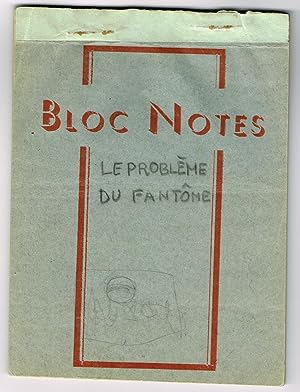

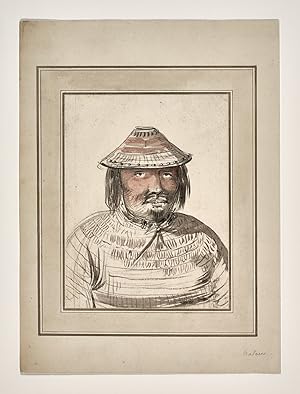
![Seller image for [Liber horarum - Use of Rouen]. for sale by Antiquariat INLIBRIS Gilhofer Nfg. GmbH](https://pictures.abebooks.com/inventory/md/md31786852342.jpg)
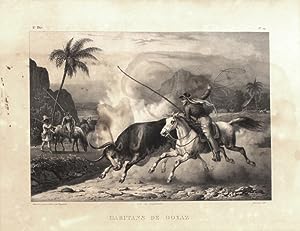
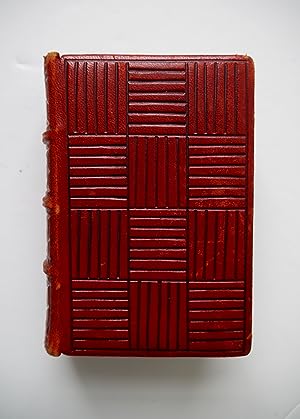
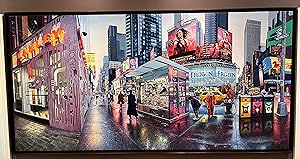
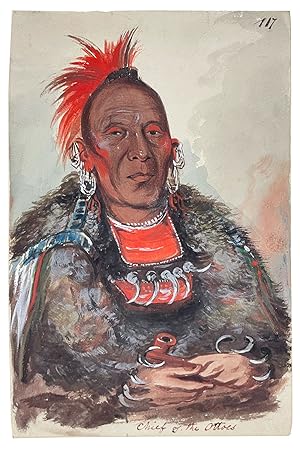
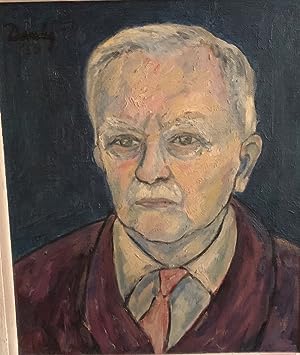
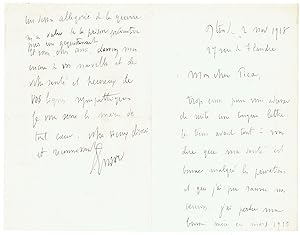
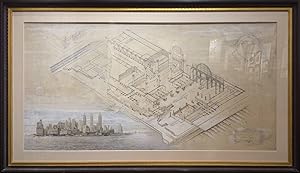
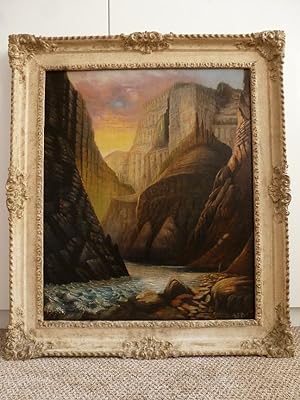
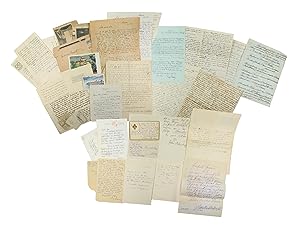
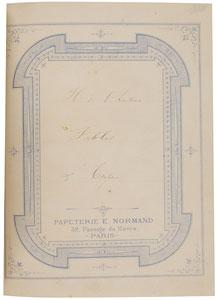
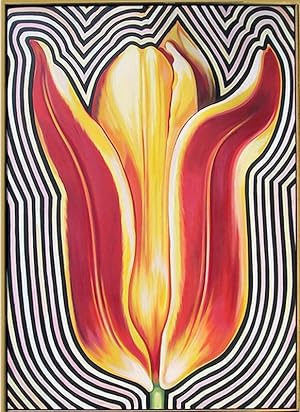
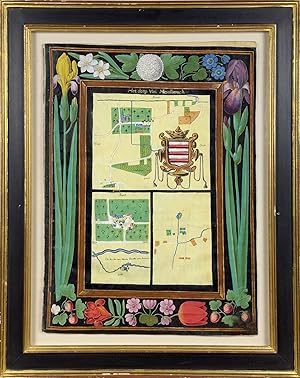
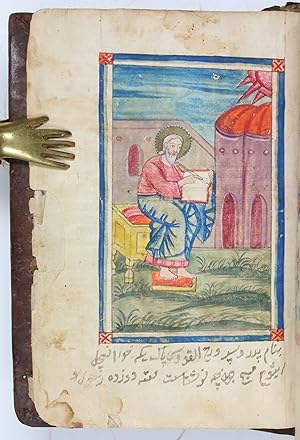
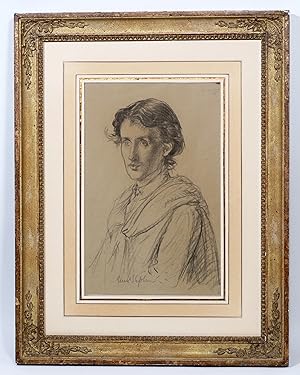
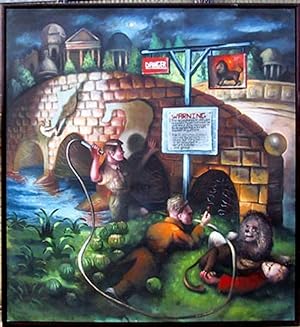
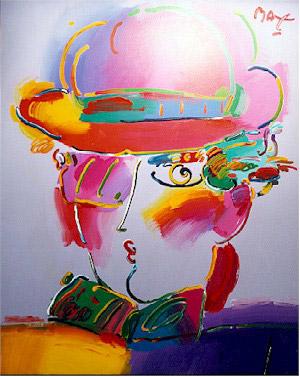
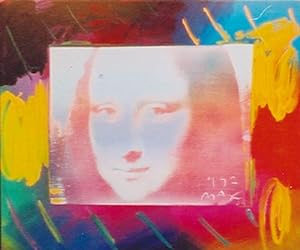
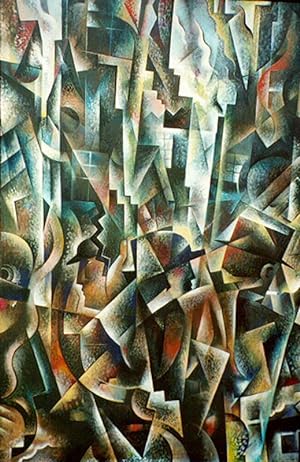
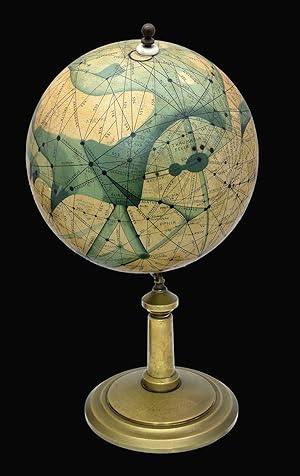
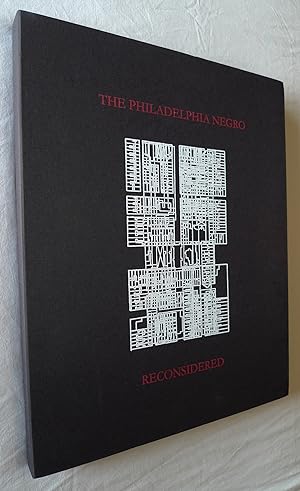
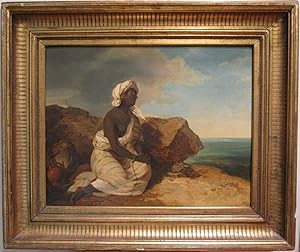
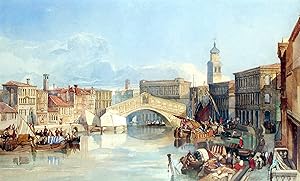
![Seller image for Two Standing by Indian Lake [Mixed Media Painting] for sale by Manhattan Rare Book Company, ABAA, ILAB](https://pictures.abebooks.com/inventory/md/md31025995367.jpg)
